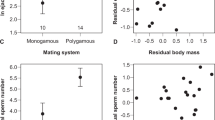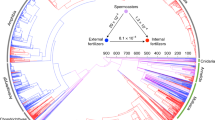Abstract
Research into the evolution of giant sperm has uncovered a paradox within the foundations of sexual selection theory. Postcopulatory sexual selection on males (that is, sperm competition and cryptic female choice) can lead to decreased sperm numbers by favouring the production of larger sperm1. However, a decline in sperm numbers is predicted to weaken selection on males and increase selection on females2,3. As isogamy is approached (that is, as investment per gamete by males approaches that by females), sperm become less abundant, ova become relatively less rare, and competition between males for fertilization success is predicted to weaken. Sexual selection for longer sperm, therefore, is expected to be self limiting. Here we examine this paradox in Drosophila along the anisogamy–isogamy continuum using intraspecific experimental evolution techniques and interspecific comparative techniques. Our results confirm the big-sperm paradox by showing that the sex difference in sexual selection gradients4 decreases as sperm size increases. However, a resolution to the paradox is provided when this finding is interpreted in concert with the ‘opportunity for selection’ and the ‘opportunity for sexual selection’5,6. Furthermore, we show that most of the variation in measures of selection intensity is explained by sperm length and relative investment in sperm production.
This is a preview of subscription content, access via your institution
Access options
Subscribe to this journal
Receive 51 print issues and online access
$199.00 per year
only $3.90 per issue
Buy this article
- Purchase on Springer Link
- Instant access to full article PDF
Prices may be subject to local taxes which are calculated during checkout



Similar content being viewed by others
References
Miller, G. T. & Pitnick, S. Sperm–female coevolution in Drosophila. Science 298, 1230–1233 (2002)
Bateman, A. J. Intrasexual selection in Drosophila. Heredity 2, 349–368 (1948)
Trivers, R. L. in Sexual Selection and the Descent of Man (ed. Campbell, B.) 52–97 (Aldine Publishing, Chicago, 1972)
Arnold, S. J. Bateman's principals and the measurement of sexual selection in plants and animals. Am. Nat. 144, s126–s149 (1994)
Wade, M. J. Sexual selection and variance in reproductive success. Am. Nat. 114, 742–747 (1979)
Wade, M. J. & Arnold, S. J. The intensity of sexual selection in relation to male sexual behaviour, female choice, and sperm precedence. Anim. Behav. 28, 446–461 (1980)
Emlen, S. & Oring, L. W. Ecology, sexual selection, and the evolution of mating systems. Science 197, 215–223 (1977)
Clutton-Brock, T. H. & Parker, G. A. Potential reproductive rates and the operation of sexual selection. Q. Rev. Biol. 67, 437–456 (1992)
Shuster, S. M. & Wade, M. J. Mating Systems and Strategies (Princeton Univ. Press, Princeton, New Jersey, 2003)
Jones, A. G., Rosenqvist, G., Anders, B., Arnold, S. J. & Avise, J. C. The Bateman gradient and the cause of sexual selection in a sex-role-reversed pipefish. Proc. R. Soc. Lond. B 267, 677–680 (2000)
Jones, A. G., Arguello, J. R. & Arnold, S. J. Validation of Bateman's principles: a genetic study of mating patterns and sexual selection in newts. Proc. R. Soc. Lond. B 269, 2533–2539 (2002)
Kokko, H. & Jennions, M. It takes two to tango. Trends Ecol. Evol. 18, 103–104 (2003)
Lorch, P. D. Understanding reversals in the relative strength of sexual selection on males and females: a role for sperm competition? Am. Nat. 159, 645–657 (2002)
Parker, G. A. Sperm competition and its evolutionary consequences in insects. Biol. Rev. 45, 525–567 (1970)
Parker, G. A. Why are there so many tiny sperm? Sperm competition and the maintenance of two sexes. J. Theor. Biol. 96, 281–294 (1982)
Parker, G. A., Baker, R. R. & Smith, V. G. F. The origin of evolution of gamete dimorphism and the male–female phenomenon. J. Theor. Biol. 36, 529–553 (1972)
Briskie, J. V. & Montgomerie, R. Sperm size and sperm competition in birds. Proc. R. Soc. Lond. B 247, 89–95 (1992)
Gage, M. J. G. Associations between body size, mating pattern, testis size, and sperm lengths across butterflies. Proc. R. Soc. Lond. B 258, 247–254 (1994)
LaMunyon, C. W. & Ward, S. Evolution of larger sperm in response to experimentally increased sperm competition in Caenorhabditis elegans. Proc. R. Soc. Lond. B 269, 1125–1128 (2002)
Pitnick, S., Markow, T. A. & Spicer, G. S. Delayed male maturity is a cost of producing large sperm in Drosophila. Proc. Natl Acad. Sci. USA 92, 10614–10618 (1995)
Pitnick, S. Investment in testes and the cost of making long sperm in Drosophila. Am. Nat. 148, 57–80 (1996)
Pitnick, S. & Markow, T. A. Male gametic strategies: sperm size, testes size, and the allocation of ejaculate among successive mates by the sperm-limited fly Drosophila pachea and its relatives. Am. Nat. 143, 785–819 (1994)
Joly, D., Bressac, C., Devaux, J. & Lachaise, D. Sperm length diversity in Drosophilidae. Drosoph. Inf. Serv. 70, 104–108 (1991)
Pitnick, S., Spicer, G. S. & Markow, T. A. Phylogenetic examination of female incorporation of ejaculates in Drosophila. Evolution 51, 833–845 (1997)
Pitnick, S., Spicer, G. S. & Markow, T. A. How long is a giant sperm? Nature 375, 109 (1995)
Jones, A. G., Arguello, J. R. & Arnold, S. J. Molecular parentage analysis in experimental newt populations: the response of mating system measures to variation in the operational sex ratio. Am. Nat. 164, 444–456 (2004)
Karr, T. L. & Pitnick, S. The ins and outs of fertilization. Nature 379, 405–406 (1996)
Andersson, M. Sexual Selection (Princeton Univ. Press, Princeton, New Jersey, 1994)
Markow, T. A. & Sawka, S. Dynamics of mating success in experimental groups of Drosophila melanogaster (Diptera: Drosophilidae). J. Insect Behav. 5, 375–383 (1992)
Acknowledgements
We thank R. Dallai for contributing the scanning electron micrographs of Drosophila bifurca for Fig. 1, W. T. Starmer for statistical advice, B. A. Byrnes for technical assistance, W. J. Etges for directions to the D. bifurca collection site in Mexico, and C. Hubbell and SUNY Upstate Medical University for providing access to the gamma irradiator. We are also indebted to S. M. Shuster, M. J. Wade, S. J. Arnold, M. Kirkpatrick, G. A. Parker, R. Lande, R. A. Schmedicke, L. L. Wolf, W. T. Starmer, W. D. Brown, J. A. C. Uy and G. T. Miller for discussion of our data and/or comments on an earlier draft of this manuscript. This work was supported by a National Science Foundation Grant to S.P. and A.B.
Author information
Authors and Affiliations
Corresponding author
Ethics declarations
Competing interests
Reprints and permissions information is available at npg.nature.com/reprintsandpermissions. The authors declare no competing financial interests.
Supplementary information
Supplementary Table 1
Summary of the slopes of the sexual selection gradients presented in Figure 2. (PDF 40 kb)
Supplementary Methods
Full description of methods and analyses used in this study. (PDF 66 kb)
Rights and permissions
About this article
Cite this article
Bjork, A., Pitnick, S. Intensity of sexual selection along the anisogamy–isogamy continuum. Nature 441, 742–745 (2006). https://doi.org/10.1038/nature04683
Received:
Accepted:
Issue Date:
DOI: https://doi.org/10.1038/nature04683
This article is cited by
-
Degree of anisogamy is unrelated to the intensity of sexual selection
Scientific Reports (2021)
-
Sex peptide receptor-regulated polyandry modulates the balance of pre- and post-copulatory sexual selection in Drosophila
Nature Communications (2019)
-
How sexual selection can drive the evolution of costly sperm ornamentation
Nature (2016)
-
Adaptive Significance and Long-Term Survival of Asexual Lineages
Evolutionary Biology (2013)
-
The ultrastructure of the spermatozoon of Octopus ocellatus Gray, 1849 (Cephalopoda: Octopoda)
Chinese Journal of Oceanology and Limnology (2011)
Comments
By submitting a comment you agree to abide by our Terms and Community Guidelines. If you find something abusive or that does not comply with our terms or guidelines please flag it as inappropriate.



